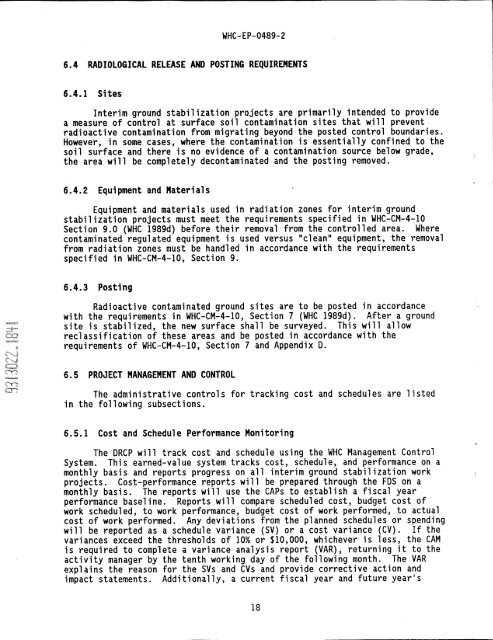IS PAGEli - Hanford Site
IS PAGEli - Hanford Site
IS PAGEli - Hanford Site
Create successful ePaper yourself
Turn your PDF publications into a flip-book with our unique Google optimized e-Paper software.
WHC-EP-0489-2<br />
6.4 RADIOLOGICAL RELEASE AND POSTING REQUIREMENTS<br />
6.4.1 <strong>Site</strong>s<br />
Interim ground stabilization projects are primarily intended to provide<br />
a measure of control at surface soil contamination sites that will prevent<br />
radioactive contamination from migrating beyond the posted control boundaries.<br />
However, in some cases, where the contamination is essentially confined to the<br />
soil surface and there is no evidence of a contamination source below grade,<br />
the area will be completely decontaminated and the posting removed.<br />
6.4.2 Equipment and Materials<br />
Equipment and materials used in radiation zones for interim ground<br />
stabilization projects must meet the requirements specified in WHC-CM-4-10<br />
Section 9.0 (WHC 1989d) before their removal from the controlled area. Where<br />
contaminated regulated equipment is used versus "clean" equipment, the removal<br />
from radiation zones must be handled in accordance with the requirements<br />
specified in WHC-CM-4-10, Section 9.<br />
6.4.3 Posting<br />
Radioactive contaminated ground sites are to be posted in accordance<br />
with the requirements in WHC-CM-4-1O, Section 7 (WHC 1989d). After a ground<br />
site is stabilized, the new surface shall be surveyed. This will allow<br />
reclassification of these areas and be posted in accordance with the<br />
requirements of WHC-CM-4-1O, Section 7 and Appendix 0.<br />
6.5 PROJECT MANAGEMENT AND CONTROL<br />
The administrative controls for tracking cost and schedules are listed<br />
in the following subsections.<br />
6.5.1 Cost and Schedule Performance Monitoring<br />
The DRCP will track cost and schedule using the WHC Management Control<br />
System. This earned-value system tracks cost, schedule, and performance on a<br />
monthly basis and reports progress on all interim ground stabilization work<br />
projects. Cost-performance reports will be prepared through the FDS on a<br />
monthly basis. The reports will use the CAPs to establish a fiscal year<br />
performance baseline. Reports will compare scheduled cost, budget cost of<br />
work scheduled, to work performance, budget cost of work performed, to actual<br />
cost of work performed. Any deviations from the planned schedules or spending<br />
will be reported as a schedule variance (SV) or a cost variance (CV). If the<br />
variances exceed the thresholds of 10% or $10,000, whichever is less, the CAM<br />
is required to complete a variance analysis report (VAR), returning it to the<br />
activity manager by the tenth working day of the following month. The VAR<br />
explains the reason for the SVs and CVs and provide corrective action and<br />
impact statements. Additionally, a current fiscal year and future year's<br />
18

















